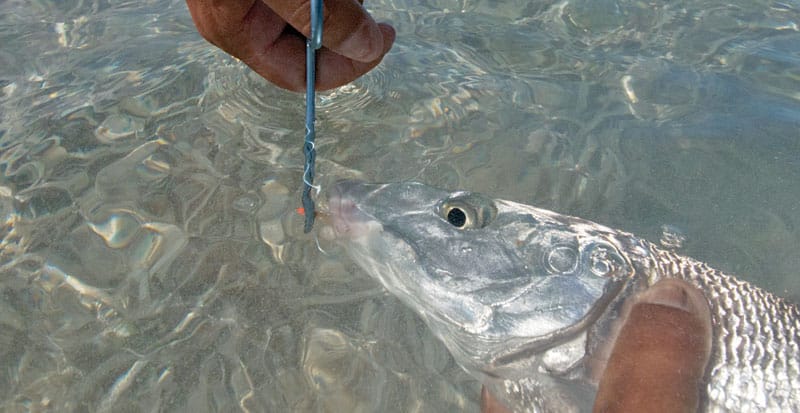
catch and release
Thankfully, catch-and-release fishing is becoming more common by the day. For many anglers, setting fish free to fight again has simply become part of their catching ritual. While releasing species such as bonefish, tarpon and permit is pretty much a given, a good number of anglers extend this practice to virtually every fish they catch, no matter the species. As legendary fly-fisherman Lee Wulff said, “A fish is too valuable to be caught only once.”
Ironically, even anglers who keep a fish or two for the plate participate in catch-and-release. Just think about it. What happens when a fish is caught out of season or isn’t a legal size — too small, or not within the slot limit? The angler has to put it back, and hence practice catch-and-release. In Florida, for example, it’s been estimated that approximately half of all fish caught by recreational anglers are released — some as general practice, and many because of size or bag limits. And with snook, one of the most popular game fish in the state, it is estimated that more than 95 percent of caught fish are released.
Wulff’s famous statement implied that catch-and-release should be viewed as a valuable tool that allows anglers to take part in and enjoy fishing without damaging the resource. What’s important for us all to keep in mind is that this proven conservation method is effective only when practiced correctly. Fortunately, a growing number of scientists have been conducting research to figure out the best ways to capture, handle and release fish to ensure their survival.
While a good number of fishermen already follow good catch-and-release practices, many unknowingly use incorrect techniques that do more harm than good. But before we start finger-pointing, let’s agree to admit that we’ve all handled fish improperly in the past. We just didn’t know any better. Even today, with a closer look at data gathered through studies on catch-and-release fishing, we’re learning a lot about the do’s and don’ts of handling caught fish.
Air Exposure
To a great extent, fly-anglers have it relatively easy when it comes to catch-and-release. Typically, flies are not swallowed by fish, so we don’t have to be overly concerned about hooking a fish in the gullet. But even in that rare situation in which a fly is taken deeply by a fish, the safest solution is to cut the line as close to the hook as you can and release the fish. Research on bonefish, for example, has shown that leaving the hook in the fish does not affect the fish’s behavior or survival or result in any weight loss. Work on other species has shown similar results. Leaving the hook in the fish is generally better than the damage that’s caused by digging around to remove it and also takes less time, plus you may not even need to take the fish out of the water.
Reducing the fish’s exposure to air is another big issue. Work on bonefish conducted at the Cape Eleuthera Institute, in the Bahamas, showed
that bonefish exposed to air for too long a time had a much higher chance of dying after being released. The scientists’ recommendation was that bonefish should be exposed to air a maximum of 15 seconds. It’s safe to use this as a ground rule with other coastal game fish as well. In addition, recent research determined that every minute the gills of a bonefish are exposed to air, the odds of its getting eaten by a shark or barracuda increase 6 times.
Handling with Care
Unless you want a photograph, limit the amount of time you handle the fish. In general, more handling time means more trouble for the fish. Using a barbless hook drastically decreases the amount of time you need to safely remove the hook and send the fish on its way.
Keeping the fish in the water is by far the best thing you can do to ensure a safe release, and if you do handle the fish, make sure your hands are wet. Using towels, cotton gloves or other items for gripping almost always increases the amount of slime removed from the fish.
All fish species have their own opti-mal conditions for survival, and water temperature plays a major role, without exception. If the water is considerably colder or warmer than a fish’s comfort zone, then the fish is less likely to handle catch-and-release well. When conditions are on the edge of a fish’s tolerance, be extra vigilant about reducing handling time and eliminating air exposure before releasing the fish.
If you need to revive a fish prior to release, make sure that water is flowing into the mouth and out of the gills. The gills are designed to get oxygen as water moves from front to back, and reversing this movement by moving the fish back and forth can actually inhibit the intake of new oxygen. If you need to, make figure-eight patterns with the fish in the water so that it’s always moving forward.
Catching fish on fly tackle is such a fantastic experience, we owe it to ourselves and future anglers to do our part and practice responsible catch-and-release fishing.
_
■ Aaron J. Adams is the director of operations for Bonefish & Tarpon Trust and a senior scientist at Mote Marine Laboratory. In addition to overseeing BTT’s work, he conducts fish ecology research.
■ Andy J. Danylchuk is assistant professor of fish conservation for the Department of Environmental Conservation at the University of Massachusetts Amherst, where he takes part in research on the effects of catch-and-release and other fishy topics.
_









